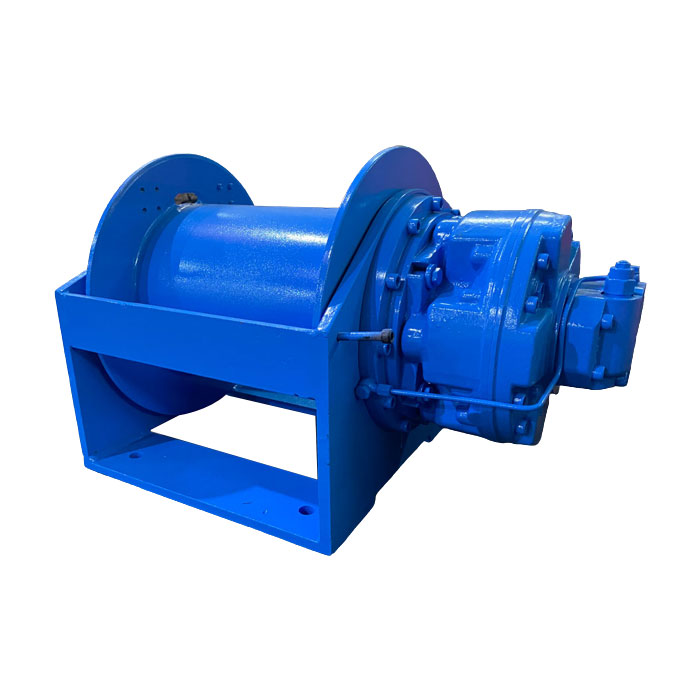Components of a Hydraulic Winch
2024-05-29
A 2.5-ton hydraulic winch is a heavy-duty mechanical device used for lifting, pulling, and towing applications in various industries such as construction, forestry, mining, and marine. This type of winch utilizes hydraulic power to operate and is capable of handling loads up to 2.5 tons (or approximately 5000 pounds). Here's an overview of a 2.5-ton hydraulic winch, including its features, components, and applications:
Features of a 2.5-Ton Hydraulic Winch:
1. High Load Capacity: A 2.5-ton hydraulic winch is designed to handle heavy loads weighing up to 2.5 tons, making it suitable for a wide range of lifting and pulling tasks.
2. Hydraulic Power: Unlike electric winches that rely on electrical power, hydraulic winches are powered by hydraulic systems, typically using hydraulic fluid pressurized by a pump to generate pulling force.
3. Durable Construction: Hydraulic winches are built with robust materials such as steel and heavy-duty components to withstand heavy loads, harsh environmental conditions, and rugged operating conditions.
4. Smooth Operation: Hydraulic winches offer smooth and precise control over lifting and pulling operations, allowing for gradual acceleration and deceleration of loads with minimal jerking or sudden movements.
5. Variable Speed Control: Many hydraulic winches feature variable speed control mechanisms that allow operators to adjust the pulling speed according to the load requirements and operating conditions.
6. Automatic Brake System: Hydraulic winches are equipped with automatic brake systems that engage when the winch is not actively pulling or lifting, providing added safety and preventing unintended movement of the load.
7. Remote Control: Some hydraulic winches come with remote control options, allowing operators to operate the winch from a safe distance and providing flexibility in positioning and maneuvering loads.
8. Mounting Options: Hydraulic winches can be mounted on various types of equipment and vehicles, including trucks, trailers, cranes, and heavy machinery, to provide versatile lifting and pulling capabilities.
Components of a Hydraulic Winch:
1. Hydraulic Motor: The hydraulic motor converts hydraulic fluid pressure into mechanical power to drive the winch drum and reel in or pay out the cable or rope.
2. Winch Drum: The winch drum is a cylindrical spool around which the cable or rope is wound. It rotates to wind or unwind the cable, allowing for lifting, pulling, or towing of loads.
3. Control Valve: The control valve regulates the flow of hydraulic fluid to the hydraulic motor, controlling the direction and speed of winch operation.
4. Brake System: Hydraulic winches are equipped with braking systems, such as disc brakes or band brakes, to hold the load in place and prevent the winch drum from unwinding when not in use.
5. Cable or Rope: The cable or rope is attached to the load being lifted or pulled and wound around the winch drum. It provides the tensile strength and durability required for lifting and pulling operations.
6. Frame or Mounting Plate: The frame or mounting plate provides the structural support for the winch and facilitates installation on vehicles, equipment, or stationary structures.
Applications of a 2.5-Ton Hydraulic Winch:
1. Off-Road Vehicles: Hydraulic winches are commonly used on off-road vehicles such as trucks, SUVs, and ATVs for self-recovery, vehicle extraction, and towing in rugged terrain and challenging off-road conditions.
2. Construction and Forestry: Hydraulic winches are employed in construction and forestry operations for lifting and pulling heavy materials, equipment, and logs, as well as for positioning and anchoring machinery.
3. Marine and Shipping: Hydraulic winches are used on ships, boats, and marine vessels for mooring, anchoring, and towing operations, as well as for launching and retrieving boats and watercraft.
4. Mining and Quarrying: Hydraulic winches are utilized in mining and quarrying operations for hauling, hoisting, and positioning heavy loads, equipment, and materials in underground and surface mining environments.
5. Material Handling: Hydraulic winches find applications in material handling and industrial lifting tasks such as loading and unloading cargo, moving machinery, and positioning heavy components in manufacturing and warehousing facilities.
6. Emergency and Rescue: Hydraulic winches are used by emergency responders, search and rescue teams, and recovery professionals for vehicle extrication, structural collapse, and other emergency response operations.
Conclusion:
A 2.5-ton hydraulic winch is a powerful and versatile tool for lifting, pulling, and towing heavy loads in a wide range of industrial, commercial, and recreational applications. With their robust construction, smooth operation, and precise control, hydraulic winches provide reliable performance and safety in demanding environments and challenging operating conditions. Whether used on off-road vehicles, construction sites, marine vessels, or industrial facilities, a 2.5-ton hydraulic winch offers the capability and versatility needed to tackle a variety of lifting and pulling tasks with ease and efficiency.



